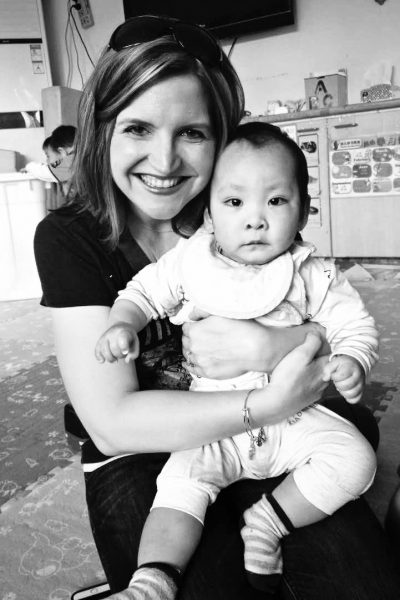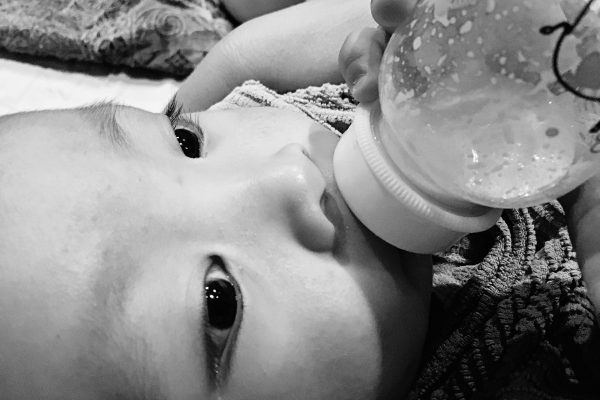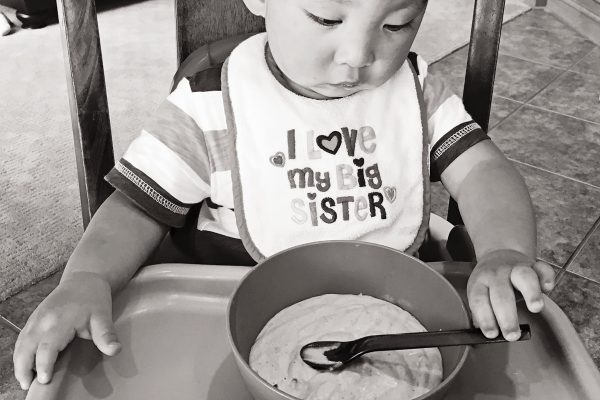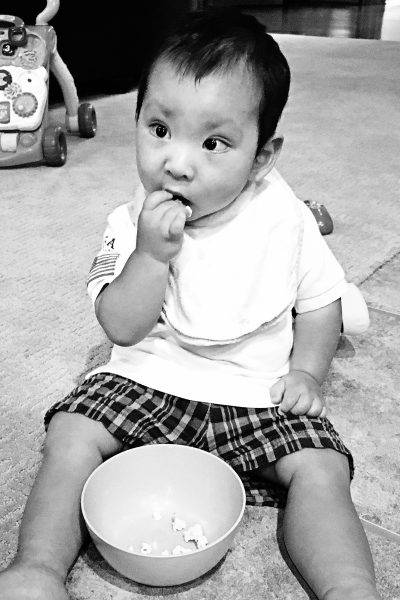Where I grew up, food was a love language. I learned at a very young age that food was the center of any worthwhile gathering. I remember once in the sweltering heat of a Mississippi summer, we attended a family reunion. It was a potluck, and table after table was overflowing with plates of styrofoam and Corelle, casserole dishes and trifle bowls. Giant pickle jugs held sweet tea and lemonade. The food spread was so expansive, you couldn’t possibly even try a small bite of everything there. Your stomach simply didn’t have the capacity.
It was how we celebrated.
Bridal showers, baby showers, and birthdays were adorned with beautiful arrangements of appetizers, cakes, cookies and petit fours.
It was also how we grieved.
My father died unexpectedly when I was a child, and so many people brought food that we couldn’t even store it all in the kitchen. Dishes were stuffed into the refrigerator. They took up all the space on the countertop. After that ran out, people left them on the piano in our family room.
Food wasn’t just sustenance. It was love.
Although my husband and I moved away from the south, we took those roots with us. Food is still a love language to me. I delight in cooking for my family and having people over to eat with us. Our kids’ birthday parties are as much as about the meal as they are about the cake, ice cream, and presents.
And our kids? It must be in the genes. They love to cook too, and they love to eat. It is sometimes shocking the amount of food our family can consume. We have never left a restaurant with food on any plate. “You gonna eat that?” is practically our family motto.
Our adoption in 2015 added our fourth child to the family. Caleb was 12.5 months at adoption, and little dude could hang right with the rest of the family in terms of food consumption. The orphanage stated that he took four bottles per day, but on our first day together in China, he began eating quite heartily from our plates. He abandoned the bottle pretty soon after he came home in favor of drinking spicy salsa from the tiny bowls at the Mexican restaurant and eating corn on the cob.
Naturally, we thought that when we adopted again in 2016, this time a baby slightly older, we wouldn’t need any “baby” foods. Caston was almost 17 months old, and we expected a child that was a pretty independent eater. When we asked for a final update before travel, the foster home staff said his favorite foods were milk and cake. We laughed. Obviously! “He’ll fit right in,” we joked. I threw some toddler favorites, puffs, and packages of squeezy applesauce into our luggage for Caleb (then two years old) and Caston (then 17 months old). “Too old for bibs,” I thought, and tossed them aside.
When we met our newest son, it was evident that we had grossly overestimated his developmental age. He was very “floppy”, and his mouth hung open with a constant stream of drool trickling out… so much that my husband and teen son had to go out and buy several bibs. Caston soaked through them in a matter of minutes. We had to wash them mid-day and dry them with the hair dryer while we were in China.

My first attempt at giving Caston a bottle proved to be tricky. We couldn’t get the consistency and temperature of the bottle just right for him. Too thick, and he couldn’t drink it. Too thin, and he choked. When I tried to cradle him during feeding, he arched back with force. He wanted to be completely flat. He and I “fought” about this, as I (his mommy) knew this wasn’t good for babies. We agreed on a compromise of me holding him in an almost flat position and slowly trying to raise his angle from time to time. He was onto me. And he hated it.
We didn’t attempt food until the next morning at breakfast.
First, we got some soft, toddler-friendly offerings from the buffet and placed them in front of him. He arched back in the high chair with his arms drawn up by his face. He wanted nothing to do with it. So naturally, we tried feeding it to him. Again, a no-go. He threw a tantrum and cried. He didn’t even want to be in our laps when we were eating.
Now being parents of five kids, this was a new one for us.
At a year and a half, all our other kids were voracious eaters. They wanted anything and everything in their sight. We looked quizzically at our guide who was watching the marvelous meltdown in the hotel restaurant. “Try the congee. All babies eat congee,” he suggested.
We offered Caston the watery rice porridge as tears streamed down his face.
This baby, maybe the only one in China, didn’t eat congee.
We decided to back off and just make food available to him at all meals. He never took the bait. It was like he didn’t even know what to do with the food. We resolved though that while he wasn’t taking any solids right now, he was obviously not malnourished. His chubby thigh rolls spoke for themselves.

I was hopeful that when we were home, his food protest would end. Once we settled in a routine, I reasoned, and he saw the rest of the family eating, he would too.
So easy, right?
I had five kids.
So easy.
At two weeks home, I began by adding vitamin drops to his formula. That went unnoticed. Then I began mixing in some stage 1 baby food into the formula. Again, no resistance. The problem wasn’t flavor. It was the method of delivery and texture. Whatever I could get into that bottle while maintaining his preferred consistency, he would take with no protest.
Then we hit a standstill. While I could effectively give him more vitamins and nutrients, he still wouldn’t touch food or eat from a spoon. After a month of trying to feed him, he finally tried stage 1 baby food from a spoon.
It wasn’t much, but it was a victory!
Because of our feeding difficulties, we enrolled in feeding therapy at our nearby children’s hospital at five weeks home. But after the first few visits, it was evident to me that Caston would not thrive in that environment. He didn’t like the different high chair. The room was filled with distractions of laptops and toys and papers. He wasn’t comfortable with the feeding therapist offering him crushed Cheetos on the tray. As long as I was feeding him the stage 1 foods, he was ok. Anything else sent him into total meltdown.
(I feel as though I need to say that I know of many kids who have been successful in structured feeding therapy. In fact, if it were any of our four other kids, they would probably have responded better for the therapist than for me. But I also want to tell you that if this isn’t working for your child, you probably already know it, and it may be time to pursue other options.)
I did take away a lot of helpful advice from her that I implemented at home. We ultimately decided to use the services of therapists from our county’s early intervention program – Caston was far more receptive to change in his comfort zone at home.
At just over six weeks home, I began pureeing our meals and feeding them to Caston with a spoon. When I began making his foods thicker, he would tolerate it as long as there were no chunks at all. He even became receptive to the squeezy applesauce. However, he couldn’t suck it out of the pouch, so I had to squeeze it into his mouth. I didn’t care. I had successfully introduced something other than the bottle and spoon.
Around this time, it became clearer to me why Caston had such quirks… the excessive drool and the desire to lie flat to take a bottle.
He had never had to use his mouth muscles.
The cross-cut nipple that we were given in China allowed the formula and rice cereal mixture to just flow down his throat. He hadn’t needed to work to suck the bottle or to swallow his formula. Gravity did it for him. Thus, we had a new challenge. Caston needed to learn how to swallow properly.

Around two and a half months home, we hit a major milestone. He tolerated tiny bites of food: canned peaches cut into teeny tiny pieces served on a spoon. Until this point, we had never witnessed him touch a piece of food. He always held his arms away from the plate or bowl.
Then one morning, in the family room at church, he picked up his brother’s snack trap full of Cheerios. We all held our breath and didn’t move a muscle as we watched him slowly reach in and bring the Cheerio to his mouth. He rolled it around a bit and then tried to swallow it, which caused him to gag just a little. He moved it around a little more, breaking it down and eventually swallowing it.
He had successfully fed himself, and he went back for more.
I recorded the whole thing and, when I watch it now, I hear myself crying tears of joy quietly in the background. Our friends in the room teared up too because they knew the difficulties we had been facing with feeding.
This was a major turning point for Caston. Later that week, he fed himself a single grape that I had cut into twelve tiny pieces.
Our road was so painfully slow. It seemed like every step forward meant two steps back. On the days that he was successful in eating a small bite of food, he would regress and protest. There were many, many days that I spent an hour and a half feeding him each meal. His mealtime began before everyone else’s and it ended long after everyone had left the table.
There were times we ran errands a little too long, and he began crying because he was hungry after he finished his bottle. I was silently angry, thinking to myself, “Just eat the Goldfish, already!”
There were days that it was so very hard not to compare him to our other kids who snacked their time away at baseball games and cheer practice and grocery store trips. We joked that the theme of his second birthday would be Pureed Foods. We would serve up burgers and birthday cake in smoothie form for all our guests. We’d follow the lead of the birthday boy.
At three and a half months home, his diet was still mainly baby food, purees, and formula. He did eat some of his brother’s popcorn when he thought we weren’t watching. (He loves to be sneaky!) I could have never guessed at the time we sent our Letter of Intent to adopt Caston what a blessing it would be for him to have a brother only 9.5 months older. Caleb has been a huge motivator for Caston to try new things.

During this time of Caston attempting new foods, we had several scary episodes that were related to his inability to swallow properly.
Remember the ease of thickened formula making its way to his tummy? That didn’t work the same with actual solid foods. There were times during meals that he would appear to be choking, even on small pieces of food. His face would turn red and tears would spring out of his eyes. He had a very panicked look on his face. It was though he temporarily “forgot” how to swallow the food. I assume it felt stuck to him, and it scared him so much each time, that he chose to end his meal.
Over the next few months, Caston tried new foods and textures at his own (very slow) pace. I continued offering the old with the new and packing bags of baby food and formula for our outings until the day that I didn’t.
I know how silly that sounds.
The frustration and struggle just faded away as Caston made the decision to move to a completely typical diet. One day, I opened the cabinet and was surprised to see baby food and a container of rice cereal. I honestly couldn’t remember the last time I had reached for those.
I am thrilled to say that at ten months home, Caston will eat just about anything that we offer him. His snack trap is usually filled with pretzels, a food that, months ago, I could have never imagined him touching, biting, or chewing!
Caston enjoys meal time, and he delights in selecting his snacks.
I love seeing his little face scrunch up when he drinks lemonade from his sippy cup. He shivers a little from the sour shock, laughs, and then excitedly signs for “more.” He feeds himself about 75% of the time. No one in the house can have a snack now without sharing a little with Caston!
And the birthday party of Pureed Foods?
It wasn’t necessary. He was able to enjoy a big piece of birthday cake along with the rest of his family. It has been such a blessing to witness his transformation.
If I could offer advice to those of you going through similar struggles, it would be:
1. Find families that are going through this too. I found two Facebook groups to be particularly helpful: Pediatric Feeding Disorders and Adoption and Oral Aversion Support. Ask every question that’s on your mind. Someone out there can identify with you.
2. You are your child’s best advocate. Just because a feeding strategy works for one child, it doesn’t mean it will work for your child. Find the therapist that creates the most successful environment for your particular situation.
3. Celebrate even the smallest of victories. Even if it’s just one Cheerio.


























What an amazing journey! What a blessing that he has progressed so far in less than a year. I am so thankful he was matched with a family that met him where he was.
Feeding is so complicated. Our story is different but feeding still impacted our daughter daily. She is now 12 and jokes about the Feeding Clinic at the local hospital. She said “when you struggle and feel like you are choking, it is not natural to have strangers asking you questions and taking notes in a strange room. I recently read about a feeding program in Chicago that is run out of a home- like apartment. I thought that was so smart to make kids more comfortable. It sounds like you found a great balance in your own home.
Congratulations to your wonderful family and so happy your son can enjoy his food on his Birthday!
I’m so glad you wrote this. We adopted a precious 12 month old boy almost seven years ago. He was just like your son. He would only take very hot formula from a bottle with the nipple cut. He also wanted to
lay flat. We have been in and out of feeding therapy since he came home. He now eats puréed foods that are thickened to just the right consistency with baby food oatmeal and completely smooth yogurt. It is such a slow journey, but it’s so nice to hear a success story.
I do have to add that this past week, while in therapy, he accidentally licked the peanut butter side of a mini Ritz peanut butter and cracker sandwich. He started to melt down, so his therapist and I started cheering for him. His fear and anxiety quickly shifted to pride!